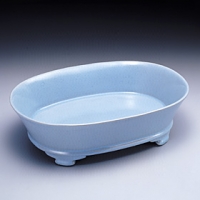|
Tags: celadon | ceramics | Ju ware | Northern Sung
Ju ware ceramics from the Northern Sung period (960-1127) are exceptionally rare, with no more than 70 pieces surviving in the entire world. Of them, the National Palace Museum houses about 21 pieces, many of which are sole surviving examples. The website "The Legend of Ju Ware" focuses on these Ju ware ceramics in the collection of the Museum and also discusses objects related to the Museum collection as well as Ju wares in other collections. The multimedia and 360 degree forms of appreciation present the legendary story of Ju ware ceramics for all.
The Celadon of Legend
Ju ware celadon, with its sky-blue glaze color, is world-renowned. Among the sky-blue glazed celadon in Chinese ceramic history, perhaps the most famous and storied is Ch’ai ware. According to the later Chou period (951-960)ruler, Ch’ai-jung, the glaze ideal was” the color of glaze should be as the sky after the rain stops and the clouds have broken through.” Recent research has found, however, that textual support that bears witness to Ch’ai ware is lacking, and no archaeological evidence remains to testify to the existence of Ch’ai ware. Related history and accounts appear later in the Ming(1368-1644)and Ch’ing(1644-1911) dynasties and accumulated gradually, and Ch’ai ware, once described as ”blue as the sky, bright as a mirror, thin as paper, resonant as a chime, ” has not been reconciled to this day with any existing archaeological evidence.
The Glaze Color of Imagination
In earlier times, scholars used the clue in historical accounts of “Ch’ai ware appearing from the north” and its characteristic sky-blue color to conclude that Ju ware celadon from Ju-chou in the Henan province succeeded and revived the Ch’ai ware of legend. In reality, this type of sky-blue glazed ceramic might be said to have descended from the “thousand blue-and-green mountains” glaze colors of the T’ang dynasty(618-907),and was the manifestation of the eternal search by scholars and gentlemen for the ideal glaze color.
The Appearance of Agate in Ju Ware Glaze
When inspecting Ju ware celadon from the side, it is possible to see from the surface of the glaze, faintly appearing around the lip and corners of the stoneware, a soft pink glow. This faint pink color gives Ju ware its tranquility, while adding to the enigmatic quality of its beauty.
Chou-hui recorded during the Southern Sung dynasty(1127-1279)in the Ch’ing-po Miscellaneous Annals(late12th c.),”Ju ware can only be made for the court, where agate is added into the glaze; if one is not selected[by the emperor], it may be sold outside, but they are difficult to obtain.” According to him, while Ju ware was being fired, powdered agate was added to the glaze. Agate was made of silica, exactly on essential glaze element. Another account by Tu-wan in Collected Rocks by Yun-lin(mid-12th c.)states,”Whether Ju-chou agate appears in sand or in water, the color is bluish-white and pink, thoroughly transparent, rarely filled with thread-like cracks within.” Agate was produced in Ju-chou, and this might have been yet another element in the tales that account for the appearance of agate in Ju ware glaze.
 |
 |
Ju Ware Narcissus Planter
Northern Sung period (960-1126)
National Palace Museum |
Ju Ware Bowl in the Shape of a Lotus
Northern Sung period (960-1126)
National Palace Museum |
Visit website
|













